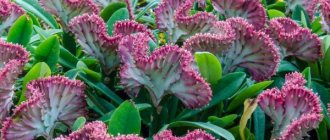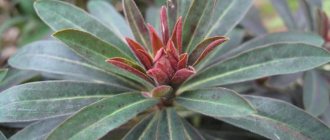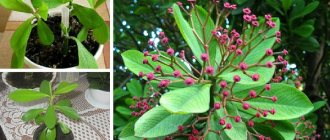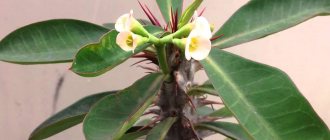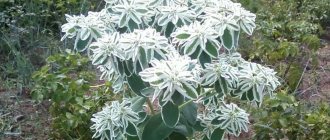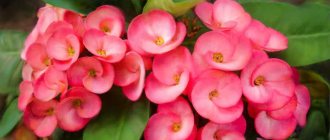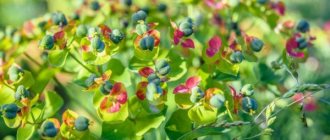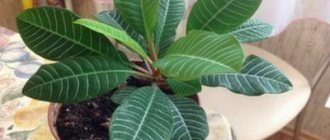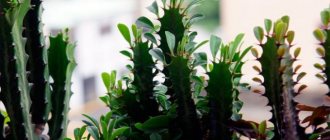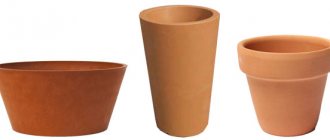Plants » Flowers
0
879
Article rating
Kira Stoletova
One of the brightest and most popular garden plants is edged euphorbia. This crop comes from the highlands of North America, belongs to the ornamental herbaceous shrubs, and attracts attention with its variegated foliage. Let's look at what the bush looks like, what care it requires and growing conditions.
Euphorbia fringed - best growing tips
What does edged spurge look like?
Euphorbia marginata in the genus Euphorbia from the family of the same name is an annual herbaceous bush 50–80 cm high with branched, upright shoots covered with numerous oval leaves about 4 cm long. The leaf blades are light green; on the eve of flowering, the edges of the upper leaves turn white, and a decorative border appears. The flowers are small and inconspicuous, surrounded by bracts with snow-white appendages.
Varieties, trademarks and synonyms of edged milkweed:
- Extra Early Snow
- Summer Icicle
- Euphorbia Early snow
- White bride
- Rhinestone
- Rich bride
- Euphorbia Mountain Snow
- Eternal Bride
- Summer snow
Possible problems in cultivation and diseases
Another positive feature of bordered milkweed is its resistance to pests and diseases. The most destructive thing for a plant is excess moisture. Resistance to pests is explained by the fact that this plant is poisonous, and insects die from the juice of the flower.
Important! At the first signs of the appearance of diseases or pests, the plant must be treated with a special product.
Euphorbia Mountain Snow
Due to its unpretentious characteristics, Euphorbia fringe is very popular among gardeners. The plant does not require careful care; after cutting, it can stand in a bouquet for 2 weeks. This flower will decorate any area with its appearance. Seeds can be purchased at any specialty store.
Choosing a site for planting bordered milkweed
The main criterion when choosing a flower bed for bordered milkweed is excellent lighting. Even with slight shading, the pagons of the plant stretch out and lose their decorative effect, and the entire shrub looks loose and weak.
The succulent develops normally on poor rocky and sandy soils, but grows especially luxuriantly on fertile soils. It can withstand drought, but flooding is harmful to it. Stagnant water has a detrimental effect on the root system.
Consequently, an area with groundwater close to the surface is not suitable for growing bordered milkweed. A low area into which all the sedimentary water flows after rain is also not suitable, so a bed for a succulent is prepared in elevated areas of the terrain.
"Snowy Peaks" in your home - what is edged milkweed? Description of the plant and its care
Euphorbia fringe is an annual plant loved by many gardeners because of its unusual decorative appearance. A wide white stripe borders its leaves, creating the effect of snowy peaks.
Although this amazing flower is unpretentious to its conditions, you still need to know the rules for caring for it.
Next you will learn about planting this flower. What methods of reproduction exist? What diseases and pests should you be wary of? And also what it looks like in the photo.
Sowing fringed milkweed in open ground
Euphorbia fringe seedlings are vulnerable to low temperatures and die in the event of return spring frosts on the soil, so they are planted in open ground in May, when their threat has already passed.
The seeds of the milkweed are quite large, so they can initially be sown at the required distance from each other, so as not to have to be thinned out later. However, if the crops are dense, individual seedlings can easily be used as seedlings and moved to another place with a lump of earth without particularly disturbing the roots.
Small grooves are made in the soil at a distance of 25–30 cm and seeds are planted to a depth of 1–2 cm, with at least 7–8 cm between them. As a result of thinning, the plants are left at a distance of at least 30–35 cm from each other.
Sowing in open ground is also carried out before winter, but they are guided by the weather forecast and choose a sowing date so that there are no more than 3-4 weeks left before frost, otherwise the seeds will germinate and the seedlings will die.
Botanical description
Euphorbia marginata is an annual herbaceous plant from the Euphorbia family. Natural habitat - landscape zones of the mountain slopes of North America.
Its erect, densely leafy stems reach a height of 60-80 cm. The leaves of the plant are oval-shaped and light green in color. When milkweed blooms, a wide white border forms on its upper leaves. Thanks to such leaves and large white bracts, the plant looks very festive and decorative. Although the flowers themselves are quite small and inconspicuous.
A large flowering bush of bordered milkweed looks like a large snowball or a bride in a magnificent robe. Because of this, the plant is also called “bride”, “mountain snow”, “early snow”, “snowy peak”. Flowering lasts from June until the first frost.
And this is what the “Snowy Peaks” flower looks like in the photo:
Sowing seeds for seedlings
Sow in March or late February. For sowing, use wide dishes filled with fertile soil for growing seedlings, or special cassettes or cups in which seedlings can be grown without picking.
The crops are moistened with a fine spray and covered with glass or plastic film. Keep in a diffusely lit place with a constant temperature of 22 to 25 degrees Celsius, ventilate regularly so that condensation does not accumulate, which can initiate damping off of the seeds.
After 1–3 weeks, seedlings will appear, and the shelter is removed, and the seedlings are slowly accustomed to the external environment. 10–12 days before planting in open ground, seedlings begin to be taken out onto the balcony or into the garden for hardening.
Rules of care
- Temperature.
The optimal temperature for plant growth is 22-25°C. But since milkweed is a succulent, it can easily tolerate higher temperatures. In the winter months, spurge is in a dormant period at a temperature of about 14°C (but not lower than 10-12°C). - Watering.
In spring and summer, you need to water the flower moderately; the soil should have time to dry out before the next watering, but should not be too dry. In the winter months, as the temperature drops, watering is reduced (no more than once every 2 weeks).Advice. Serrated spurge is resistant to dry air and does not need spraying. But for hygienic purposes, to prevent dust from accumulating, it can be occasionally sprayed with a spray bottle.
- Lighting.
This succulent loves light very much, but in summer and spring it should be accustomed to bright sunlight gradually to avoid burns. Euphorbia feels best on window sills facing south and southeast. In winter, the flower may need additional lighting with LED or fluorescent lamps. - Trimming.
You can prune a succulent only after the end of the flowering period. You need to trim the shoots by 10-15 cm so that the plant has a beautiful shape and does not waste energy on extra side branches. - Fertilizer.
Euphorbia must be fed during the periods of growth and flowering with special fertilizers for cacti or succulents, fertilizing should be done once every 2 weeks. In winter, fertilizing is not needed, since the plant is dormant.You should not use nitrogenous fertilizers for fertilizing, as they can cause cracks to form on the stems of milkweed.
- Choosing a pot.
This type requires a deep pot with fairly thick walls. When replanting, you need to take a pot 2-3 centimeters wider than the previous one.
Propagation of milkweed bordered by cuttings
You can root edged euphorbia with cuttings in the month of June. The plant will bloom a little later, but will have time to vegetate, especially in regions with late, warm autumn.
Cuttings 10 cm long are cut from the tops of the shoots and immersed with the lower end in warm water to drain the milky juice. Next, it is buried in a pot with a peat-sand mixture and covered with a glass jar on top. Place in a well-lit place with a thermometer reading of 22–26 degrees above zero and moderately moisten.
After 2–3 weeks, the first signs of rooting are already visible - new leaves begin to grow at the top of the cutting. The covering vessel can now be removed and the root system can be grown for another couple of weeks so that the plant feels stronger after planting in open ground.
Purchase and adaptation
Euphorbia seedlings are sold in gardening stores. You can also purchase seeds for growing at home with further replanting on the site.
The best time to buy seedlings is early spring. Carefully examine their above-ground part - it should be juicy, green, without yellowness or other signs of disease.
Buy grown specimens; they already have a developed root system, which means they will successfully tolerate transplantation into open ground.
Plant the plant only in warm soil
Before planting, the bushes are kept at home for some time until the street heat stabilizes and the threat of return frosts passes. The soil should warm up to 10-12°C. Within a few weeks of keeping it at home, you will be able to determine the condition of the seedlings - whether they have any diseases or parasites. If necessary, they are irrigated with fungicides or insecticides.
If you buy seed material, pay attention to the expiration date indicated on the packaging.
Caring for Euphorbia bordered
Succulent plantings are regularly weeded to prevent weeds from growing between the rows. They loosen the soil after rains, breaking the crust that has formed, which prevents air from reaching the roots.
Euphorbia fringe does not like frequent watering; it tolerates drought better than waterlogging. Only in the sultry summer heat should the plant be watered moderately once a week. Usually it has enough sedimentary moisture. If spray watering is used, the succulent noticeably comes to life and invigorates, although it does not need special spraying.
Fertilizers are usually used when growing on poor soils. Both mineral and organic fertilizers are used. Among the latter, a solution of manure is often used - 200 g per 10 liters of water, left for a day, then 1-2 liters are poured under each bush. On the eve of flowering, you can feed with phosphorus-potassium fertilizers.
There is no special need for special trimmings that form the crown. The tops of shoots of seedlings are sometimes pinched for better branching, but this work is done with rubber gloves, since the milky sap of the plant causes irritation on the skin and mucous membranes. In autumn, the above-ground part is cut off, removed from the site and disposed of.
How to care for Euphorbia marginata?
Temperature
Euphorbia mountain snow is a very heat-loving variety . Tolerates summer heat well. The optimal growth temperature is 20 – 25°C. The desired humidity level is 40 – 45%.
Watering
Thanks to its branched roots, euphorbia fringe is quite resistant to drought. Moderate watering is recommended as the top layer of soil dries. No additional spraying required.
The plant does not tolerate damp, waterlogged substrate ; excessive moisture increases the risk of infection by putrefactive bacteria. You cannot plant bushes near groundwater and reservoirs.
Light
A very light-loving variety; sunny places are required for planting.
From a lack of sun, the leaves lose their snow-white, expressive variegation. They become faded and smaller. The bush itself branches poorly, stretches out, flowering is delayed, and the inflorescences become sparse and dull.
Trimming
When growing seedlings, it is advisable to pinch the seedlings to form a lush bush. Before and after flowering, mountain snow spurge does not require additional pruning . In late autumn, the leaves are cut off and the root shoots are removed from the area.
Attention! The flower is very poisonous, so it is recommended to carry out all manipulations with gardening gloves; do not allow the juice to get into your eyes or skin.
Feeding
Euphorbia marginata grows well in ordinary garden soil; timely weeding and regular loosening of the substrate are required. During the period of active growth, you can apply complex mineral fertilizers or organic matter. It is better to apply fertilizer after sunset when watering.
Pot
The flower is unpretentious . Planting containers can be chosen from any material. Pots or containers should be spacious and deep enough to allow free root growth and good air permeability.
Watch a video about plant care and planting:
Diseases and pests
The main disease from which euphorbia fringe suffers is root rot. It affects plants in humid summers in heavily dense plantings, when air access to the base of the stem is difficult. Shrubs planted in hollows where water constantly stagnates after rains, as well as those beds that are regularly waterlogged as a result of the operation of the irrigation system, also suffer.
Unfortunately, it is almost impossible to save plants with a rotten root system; they are torn out and removed from the flowerbed. The remaining healthy shrubs are treated with a fungicide solution, spilling the soil around the root collar.
Most pests avoid planting bordered milkweed - they do not like the poisonous milky sap of the plant. However, the roots occasionally suffer from attacks by nematodes and scale insects. The soil is watered with a solution of a special preparation called nematicide, for example, heterophos, carbation, terakur and others, but before sowing, since all these agents are phytotoxic. Scale insects are destroyed by treating plants and soil with solutions of systemic insecticides.
Reproduction
At home, spurge propagates in 3 ways:
The soil for flower propagation should consist of the following components in equal proportions:
Cuttings
- Easy and fast.
- You can propagate in this way at any time of the year.
Cons: Extra caution is required as milkweed sap is highly poisonous.
Step-by-step diagram:
- pinch off a leaf with a stem;
- let the milky juice drain;
- Next, the cut should be treated with a stimulator;
- plant the cuttings in moist soil;
- cover with transparent film or cap.
Seeds
The advantages of growing “early snow” from seeds: you can get several plants at once.
- Only fresh seeds can be used.
- It is not a very fast method and requires some effort.
Step-by-step diagram:
- The seeds of milkweed are round, about 2 mm in diameter, so they need to be carefully sprinkled with the same thin layer of soil.
- Thoroughly moisten the substrate.
- Cover with a glass cap.
Dividing the bush
Pros: easy and fast.
Cons: dividing the bush can only be done when the plant is not blooming and is dormant (winter months and early spring).
Step-by-step diagram:
- Remove the mature plant from the pot.
- Divide the rhizome into several parts.
- Carefully inspect the planting material for rotting areas. Remove unhealthy parts.
- The plant is taken out of the pot and the rhizome is divided into several parts.
- Place the finished divisions in separate pots.
The best flower garden partners
Succulents are often planted in border beds, to highlight garden paths, when zoning a personal plot. With its cold beauty, it dilutes the bright palette of summer-autumn colors of flower beds. The most common neighbors in the flower garden of the bordered milkweed are ornamental grasses with phlox, marigolds, monarda and zinnias. The succulent sets off hostas well, harmonizes with agastache and Siberian irises, and combines with the discreet cuteness of black cohosh and buzulnik.
Bordered spurge in landscape design
In flower beds, Mountain Snow looks great next to phlox, ornamental grasses, and monarda. It makes an excellent backdrop for many perennials.
It goes well with hostas that also love bright sunlight. It harmonizes well with crops that have dark foliage, for example, varietal buzulniks.
If you cut it, you can use it to make bouquets, combining it with roses, hollyhocks, delphiniums, and dahlias.
Gardeners plant Mountain Snow because of its unpretentiousness and beautiful decorative leaves. It does not require frequent watering as it tolerates drought easily.
Bloom
The flowering period begins in July and ends with the onset of the first frost.
The flowers are small and white.
An amazing feature of “early snow” is that at the time of flowering, a bright white border appears on the upper leaves located under the unsightly flowers.
The plant appears to be decorated with huge caps of flowers.
This magical transformation justifies one of its names - “rich bride”.
Euphorbia bordered from seeds. Personal experience
Euphorbia fringe is a herbaceous annual plant with unsightly small flowers; its main advantage is its leaves with a snow-white border, which appears in July-August before flowering. Euphorbia grows as a lush bush up to 60 cm high on a strong stem and does not fall over. I wonder if it's easy to grow it from seeds? Well, let's try!
Growing milkweed from seeds is not that difficult. I liked the photos of it in my friends’ gardens so much that I also wanted the same pretty plant. I found milkweed seeds in two stores: in Darwin and in Leroy-Merlin, manufacturer “Prestige Seeds”, variety “Early Snow”. I'm trying to plant it for the first time. There are 20 peas in a bag with an uneven lumpy surface of a light beige color with a diameter of approximately 4-5 mm. Unfortunately, I didn't take a photo. On the package there is a recommendation for planting: plant in seedling boxes in March-April, after 45-60 days the seeds must undergo stratification.
Euphorbia seedlings bordered “Early snow” (23rd day after germination)
Stratification of milkweed seeds
Ok, I'll start everything according to the instructions. I’m calculating the planting dates... minus a month and a half from March - this is approximately mid-January. This means that it is during this period that we need to put it on stratification. To do this, I used a transparent lid from a sour cream package, 2 cotton pads soaked in Epin-Extra solution and a plastic bag. I placed the seeds between 2 cotton pads on a lid and covered them with a bag so that the moisture did not evaporate; I placed everything in the refrigerator for stratification on January 11. I ventilated the seeds every other day and checked for the presence of the first roots. On day 6, mold appeared, so the seeds were washed and treated with Fitosporin-M for seedlings. The first roots appeared on the 8th day. On day 10, I planted 12 seeds in the ground, 8 seeds never hatched. I didn’t stratify them further and threw them in the trash. I have a lot of plans for planting seeds this spring, I think 12 plants will be enough for me, even taking into account if some of the plants die before planting in open ground.
